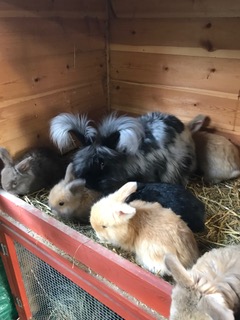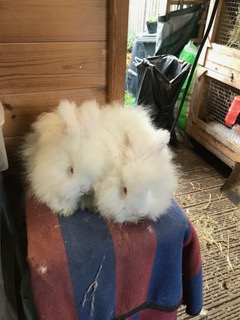
This is an article from the 1998 yearbook called ‘Ramblings” written by Mary Tomlinson. Lesley has pleaded for items for the year book, (no change) so here goes! These are not necessarily in the right order, but are being noted down as they come into my head, as the title suggests ‘Ramblings”
Helpful tip No.1
To help the digestive system I buy Papaya when they are plentiful and not too expensive. I peel and cube them, put them in plastic containers and freeze. To feed, I simply take the amount needed and slice very thinly and defrost. The bunnies love them and the Papaya helps the digestive system by dissolving debris in the system.i.e Hay, straw etc.

Helpful tip No.2
To avoid wool blockage, especially after a haircut, when the rabbit wants to wash away your smell, I always give my angoras a dose of liquid paraffin. This is administered by way of a needless syringe into the rabbits mouth, the rabbit gets a full dose and you stay reasonable clean and calm.
Helpful tip No.3
If you have wire floors, why not place an old margarine container under the spot where your rabbit spends a penny? I do this in several corners and it is amazing how much liquid is saved and not allowed to soak into the wood of the hutch.

Helpful tip No.4
If you are showing rabbits and the back end of your rabbit is getting stained it might be that your wire floor isn’t high enough. Try putting a strip of wood each side to heighten the wire floor.
Helpful tip No.5
To clean a stained rear end put a very small amount of peroxide into a container and mix with talcum powder into a paste, (simple talc has no smell) I use a pastry brush to paint it on. Let this dry and blow, you should have a much cleaner rabbit.
Helpful tip No.6
On spinning and knitting tips. When making an angora jumper I always cast on with two needles and leave out the part of ribbing , starting with the actual jumper. The borders are the last parts I knit. I try to use a lacy pattern which compliments the pattern in the actual jumper. As you might already know, angore has no give in it, unlike lambswool, and the borders and cuffs need to stretch. By knitting a border separately afterwards gives the jumper a longer life. The borders are always knitted so they fit sideways. So you are in fact knitting a long strip to sew on to the jumper. A bit laborious, but the finished item is worth it.